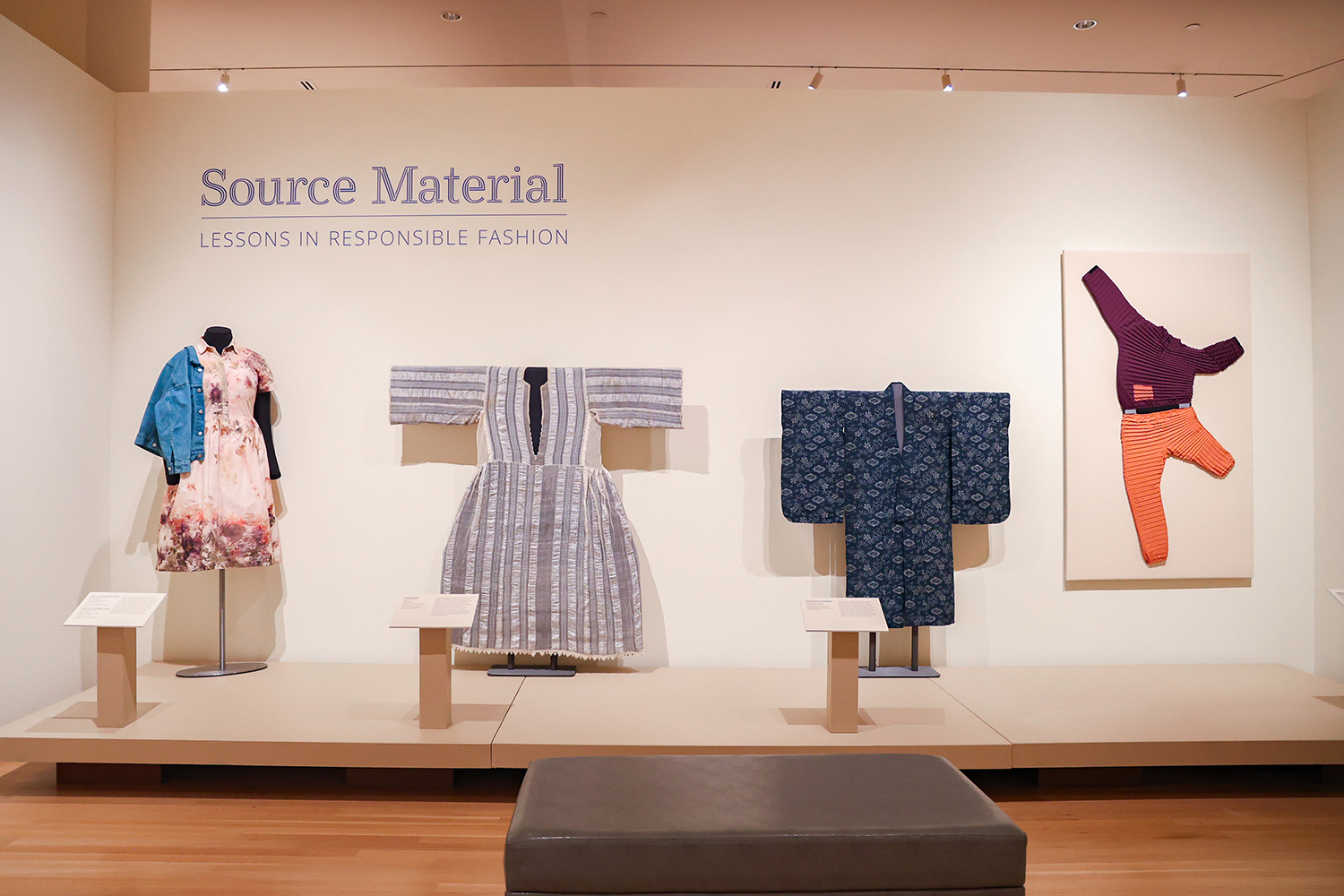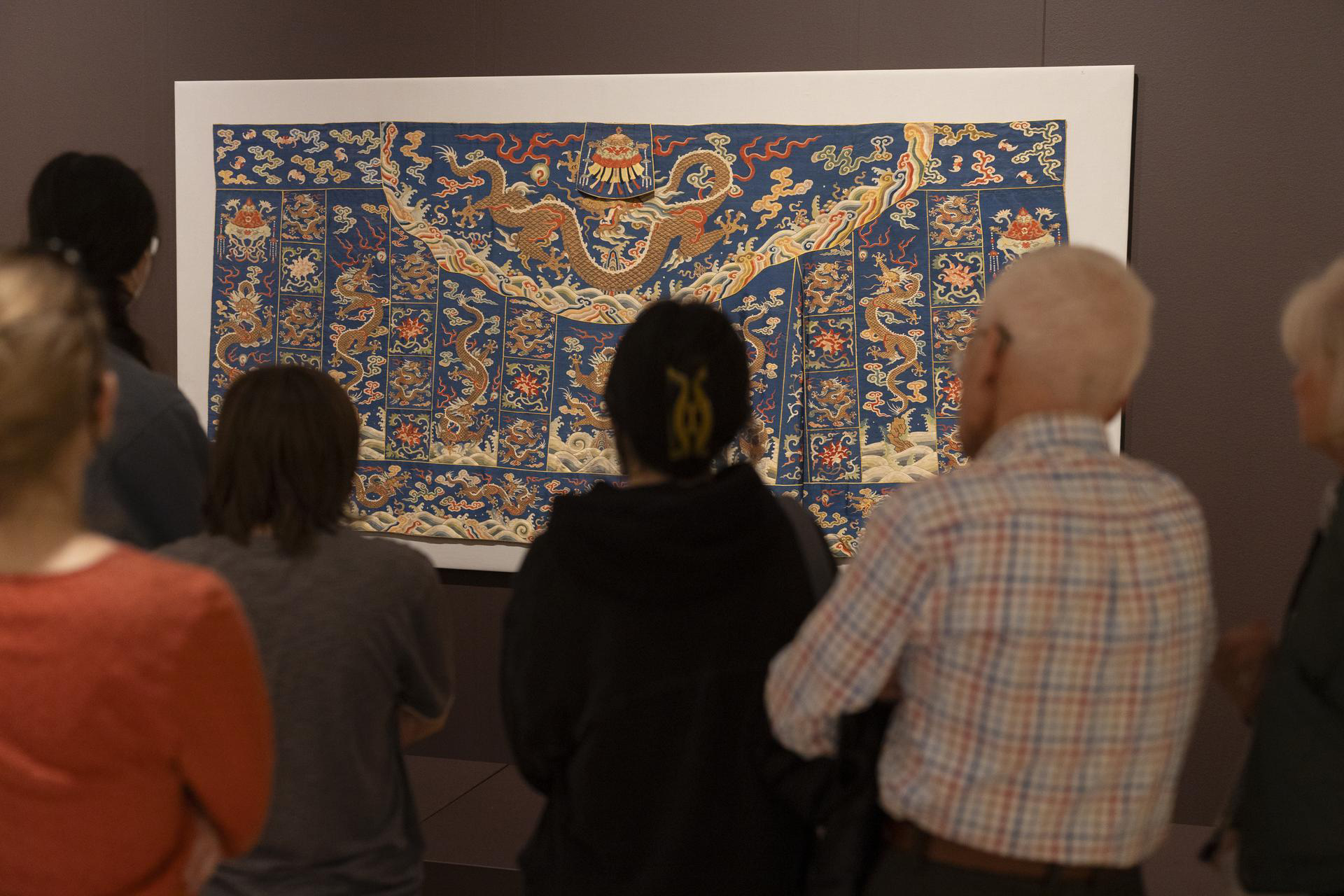The raincoat displayed on the first floor of The George Washington University Museum and The Textile Museum might not immediately catch a visitor’s eye. Made of a transparent polymer along chic but functional lines, it’s more understated than some of its spectacular neighbors in the museum’s current exhibition, “Source Material: Lessons in Responsible Fashion.”
But the raincoat, a 2019 work by designer Charlotte McCurdy called “After Ancient Sunlight,” is in some ways miraculous: It’s carbon negative, its very existence an active reduction of atmospheric pollutants. The biopolymers that constitute it were produced by a living workshop of carbon-processing algae.
McCurdy is one of several contemporary designers featured in “Source Material,” which pairs their work with historic pieces from The Textile Museum Collection to examine how makers have prioritized and continue to prioritize longevity, reusability and local resource use in an increasingly planet-unfriendly textile manufacturing landscape.
“‘Sustainability’ is a pretty recent concept,” said exhibition curator Katrina Orsini, the museum’s programs associate for academic engagement. For most of human history, she said, waste reduction, reuse and the incorporation of local materials were not abstract ecological concerns but immediate, personal ones.
Until the Industrial Revolution, textiles were too labor- and time-intensive to produce on demand. Trade routes had evolved, but they didn’t compare to our current worldwide shipping network: For the most part, if flax didn’t grow in your local biome, you didn’t wear linen. Clothing had to last, and once it was beyond repair it had to find a second life—as showcased in an Uzbek ikat panel displaying patterns of wear that indicate it was once a robe, or a strip-woven Japanese farmer’s coat into which remnants of an older garment have been reincorporated as threads.
But studies suggest Americans now re-wear clothes just seven to 10 times before discarding them. Orsini believes that average is brought down by “a lot of zeroes and ones”—garments bought to be worn on just one occasion, or never worn but considered too cheap to be worth returning. Few of our ancestors had the capacity to wear anything just once. “Historically, people liked things to last as long as possible before discarding them.”
Clothes for fast-growing children presented a problem and still do. Fortunately some solutions are perennial. For “Source Material,” Orsini paired a Meiji-era youth kimono from the museum’s collection with a space-age shirt and trouser set from Petit Pli’s LittleHuman line. The kimono is constructed with pleats to be let out as the wearer grows. Similarly, the arms, legs, neck and waist of the Petit Pli pieces are made expandable by a proprietary pleating technique and adjustable Velcro tabs. Manufactured from recycled plastic, the set is designed to be worn from ages 4 to 9.
Another perennial problem: Fabric discards created during the manufacturing process are a major source of waste at the industrial scale. Individual makers have long repurposed these scraps or patchworked them into larger pieces, both as a matter of domestic economy and for personal or ceremonial reasons. A huge 20th-century hanging from Central Asia, created from scraps donated by the community, would have been given as a gift on an occasion like a marriage or birth. In a similar spirit of preservation, contemporary designer Walid al Damirji seeks out small or damaged scraps of museum-quality historic textiles and incorporates them in his one-of-a-kind garments. Another featured designer, Zero Waste Daniel, creates playful, collaged crewnecks and swimwear from “off-cuts,” industrial scraps that would otherwise be trashed. Some designers imagine a manufacturing process that doesn’t produce these scraps in the first place: Birgitta Helmersson’s no-waste patterns are designed to be cut from the full width of a bolt of cloth with little or nothing left over.
Orsini is also interested in how artisans work with what’s locally available to them. McCurdy’s algae-built raincoat is an unconventional example: Atmospheric carbon is certainly available “in abundance,” and while that’s often expressed as a negative, it can be a valuable resource once we find a way to use it. Vietnamese-American designer Peter Do worked with manufacturer TomTex to create “leather” pieces made from the chitin in seafood shells, a major waste source in Southeast Asia. Displayed next to Do’s work is their predecessor in local-material textile innovation: a delicate 19th-century blouse woven from piña, or pineapple leaf fibers, from the museum’s collection.
“Science and innovation can be really helpful as long as we think responsibly about how much we produce,” Orsini said.
Orsini conceived the idea that became “Source Material” while teaching “Responsible Fashion,” an undergraduate course offered through GW’s minor in sustainability, and advising GW’s Responsible Fashion Collective. In the context of textile manufacturing and the global fashion industry, Orsini finds the word responsible more realistic than sustainable. Overproduction and overconsumption are central to our current manufacturing model, which has its roots in the Industrial Revolution and has accelerated in the centuries since, she said. The consequences of that model are massive: rivers polluted by runoff and dye, mountains of discarded clothes in Chile and Ghana that are now visible from space.
As her “Responsible Fashion” students examine their own patterns of consumption and realize the vastness of the systems that create this web of waste, Orsini said, the class sometimes hits an emotional wall mid-semester. That’s one reason she focuses on skill development, teaching them to understand the issues at play, articulate the problem and, if they’re driven to it, advocate for new paths forward. Her students’ voices are present in “Source Material” too. A video and interactive map designed by Grace Lemoine, B.A. ’25, and Arianna Rivadeneira, B.A. ’24, traces the geographic origins of various plant and animal materials used in the museum’s collection.
Orsini hopes visitors to “Source Material” will come away with a sense of their own agency. A takeaway guide, “Rethink Fashion,” spells out paths to more responsible consumption, starting with taking a fresh eye to what you already own. And on Saturday afternoons through Aug. 9, the museum offers a series of pop-up workshops, led by local fiber network Chesapeake Fibershed, introducing participants to local materials and handcrafting techniques like carding, spinning and weaving wool, as well as naturally dyeing yarn and processing flax. Staying connected to the local biome, like doing a careful revaluation of one’s own closet, is a way of being present with the things we wear and how they got on our body.
“Historically, if something grows or lives in a place, that fiber is probably good for the people who live there,” Orsini said.



